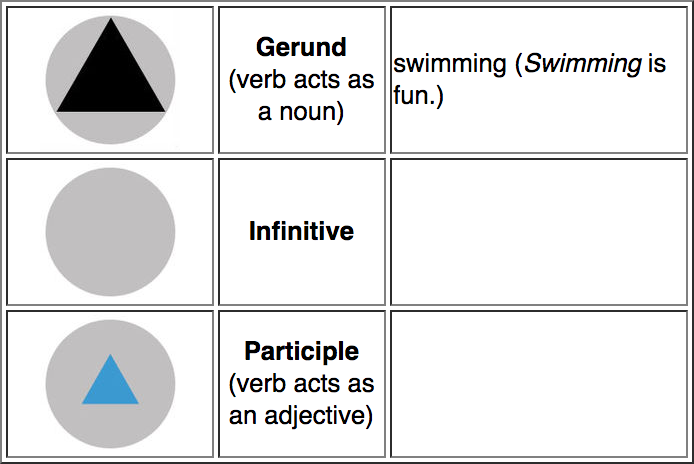In researching the conventions in functional grammar colour-coding, I came across Montessori’s grammar pedagogy. Montessori associated geometric shapes and colours with the building blocks of traditional grammar creating semiotically-rich classroom manipulatives.
In 1923, Russian painter Wassily Kandinsky created a questionnaire that asks participants to fill out three geometric shapes (triangle, square, circle) with one of three primary colours yellow, red and blue. While concerns can be raised about presenting the “correct” order of answers, the primary colour-geometry relationship that came out proved very influential and can be found in all of Kandinsky’s paintings.

Kandinsky’s questionnaire. 1923. Bauhaus Archiv, Berlin
The Museum of Modern Art (MoMA) recreated an online version of Kandinsky’s original questionnaire. This could be a great starting point and teaching and learning resource for getting student’s to think about colour-shape- and ultimately grammar associations.
Kandinsky’s student Monica Ullmann‐Broner took a step further in 1931 and associated additional “secondary” geometrical forms with secondary colours.

Monica Ullman-Broner’s secondary form-colour associations. 1931. Bauhaus Archiv, Berlin
Inspired by his contemporaries in Weimar, Maria Montessori designed objects to recontextualise formal grammar for pedagogic discourse. She came up with nine grammar symbols still used today in Montessori schools to represent “nine parts of speech” (noun, verb, adjective, adverb, article, pronoun, conjunction, preposition and interjection). Montessori further groups these into four “functional families” (‘noun family’ – noun, adjective, article, pronoun; ‘verb family’ -verb, adverb; ‘the servants’ – conjunction, preposition, and ‘special case’ – interjection). The system uses three variables: colour, shape and size. The resulting grammar symbols can be compiled into a chart. Differently-sized sets of grammar symbols can further be combined into advanced grammar symbols that facilitate semiotic discussion of more complex grammatical concepts.

Montessori ‘noun family’ grammar symbols (http://www.montessorialbum.com)

Montessori ‘verb family, the servants, and special case’ grammar symbols (http://www.montessorialbum.com)

Montessori advanced ‘noun family’ grammar symbols (http://www.montessorialbum.com)

Montessori special ‘verb family’ grammar symbols (http://www.montessorialbum.com)

Montessori advanced ‘verb family’ grammar symbols (http://www.montessorialbum.com)
- Verbs are depicted in red as circles or spheres. The verb is considered to be the central word (latin verbum) and to depict movement, actions, like a ball or the planets.
- Nouns are depicted in black-blue as triangles or pyramids. The noun is considered stable like a pyramid. The pronoun is purple because it links the noun (blue-black) with the verb (red) (see Feez, 2007, p.361).
- Modifiers reflect the shape and colour of their “parent element”, but are lighter in colours (blue for adjectives, orange for adverbs) and smaller in size.
- Conjunctions are depicted as pink rectangles. The shape is considered to symbolise a hyphen.
- Prepositions are depicted as green crescents. The shape is considered to symbolises a bridge.
- Interjections are the special case, combining circle and square in golden colour.
It is fascinating to realise how much didactic thought Maria Montessori put into recontextualising abstract formal grammar into pedagogical manipulatives. One might ask why SFL did not adopt these semiotic colours in their transitivity system, making Processes red, Participants blue, and Circumstances … well I guess yellow/golden because they make situations special? However, as Gunther Kress and Theo van Leeuwen conclude in their seminal analysis of colour as a semiotic mode: “Colour does what people do with it” (2002, p.350). So, perhaps it is then best to have children invest into their own grammar symbols and colours?
References:
- Feez, S. (2007). Montessori’s mediation of meaning: a social semiotic perspective. Learning to read with grammatics. Unpublished PhD thesis. University of Sydney, 312-366.
- Kress, G., & Van Leeuwen, T. (2002). Colour as a semiotic mode: notes for a grammar of colour. Visual communication, 1(3), 343-368.

